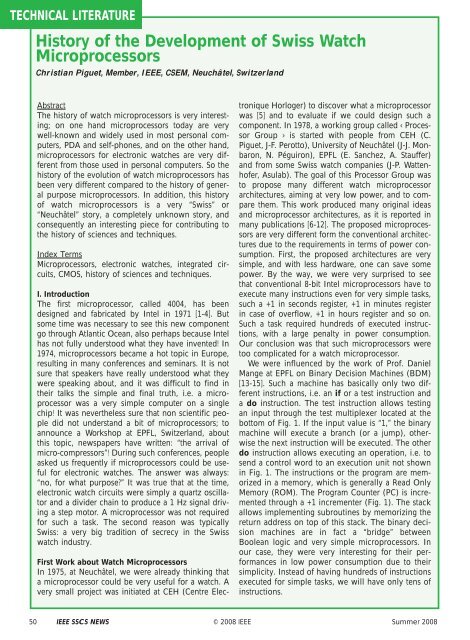Eric Vittoz - IEEE
Eric Vittoz - IEEE
Eric Vittoz - IEEE
You also want an ePaper? Increase the reach of your titles
YUMPU automatically turns print PDFs into web optimized ePapers that Google loves.
TECHNICAL LITERATURE<br />
History of the Development of Swiss Watch<br />
Microprocessors<br />
Christian Piguet, Member, <strong>IEEE</strong>, CSEM, Neuchâtel, Switzerland<br />
Abstract<br />
The history of watch microprocessors is very interesting;<br />
on one hand microprocessors today are very<br />
well-known and widely used in most personal computers,<br />
PDA and self-phones, and on the other hand,<br />
microprocessors for electronic watches are very different<br />
from those used in personal computers. So the<br />
history of the evolution of watch microprocessors has<br />
been very different compared to the history of general<br />
purpose microprocessors. In addition, this history<br />
of watch microprocessors is a very “Swiss” or<br />
“Neuchâtel” story, a completely unknown story, and<br />
consequently an interesting piece for contributing to<br />
the history of sciences and techniques.<br />
Index Terms<br />
Microprocessors, electronic watches, integrated circuits,<br />
CMOS, history of sciences and techniques.<br />
I. Introduction<br />
The first microprocessor, called 4004, has been<br />
designed and fabricated by Intel in 1971 [1-4]. But<br />
some time was necessary to see this new component<br />
go through Atlantic Ocean, also perhaps because Intel<br />
has not fully understood what they have invented! In<br />
1974, microprocessors became a hot topic in Europe,<br />
resulting in many conferences and seminars. It is not<br />
sure that speakers have really understood what they<br />
were speaking about, and it was difficult to find in<br />
their talks the simple and final truth, i.e. a microprocessor<br />
was a very simple computer on a single<br />
chip! It was nevertheless sure that non scientific people<br />
did not understand a bit of microprocessors; to<br />
announce a Workshop at EPFL, Switzerland, about<br />
this topic, newspapers have written: “the arrival of<br />
micro-compressors”! During such conferences, people<br />
asked us frequently if microprocessors could be useful<br />
for electronic watches. The answer was always:<br />
“no, for what purpose?” It was true that at the time,<br />
electronic watch circuits were simply a quartz oscillator<br />
and a divider chain to produce a 1 Hz signal driving<br />
a step motor. A microprocessor was not required<br />
for such a task. The second reason was typically<br />
Swiss: a very big tradition of secrecy in the Swiss<br />
watch industry.<br />
First Work about Watch Microprocessors<br />
In 1975, at Neuchâtel, we were already thinking that<br />
a microprocessor could be very useful for a watch. A<br />
very small project was initiated at CEH (Centre Elec-<br />
tronique Horloger) to discover what a microprocessor<br />
was [5] and to evaluate if we could design such a<br />
component. In 1978, a working group called « Processor<br />
Group » is started with people from CEH (C.<br />
Piguet, J-F. Perotto), University of Neuchâtel (J-J. Monbaron,<br />
N. Péguiron), EPFL (E. Sanchez, A. Stauffer)<br />
and from some Swiss watch companies (J-P. Wattenhofer,<br />
Asulab). The goal of this Processor Group was<br />
to propose many different watch microprocessor<br />
architectures, aiming at very low power, and to compare<br />
them. This work produced many original ideas<br />
and microprocessor architectures, as it is reported in<br />
many publications [6-12]. The proposed microprocessors<br />
are very different form the conventional architectures<br />
due to the requirements in terms of power consumption.<br />
First, the proposed architectures are very<br />
simple, and with less hardware, one can save some<br />
power. By the way, we were very surprised to see<br />
that conventional 8-bit Intel microprocessors have to<br />
execute many instructions even for very simple tasks,<br />
such a +1 in seconds register, +1 in minutes register<br />
in case of overflow, +1 in hours register and so on.<br />
Such a task required hundreds of executed instructions,<br />
with a large penalty in power consumption.<br />
Our conclusion was that such microprocessors were<br />
too complicated for a watch microprocessor.<br />
We were influenced by the work of Prof. Daniel<br />
Mange at EPFL on Binary Decision Machines (BDM)<br />
[13-15]. Such a machine has basically only two different<br />
instructions, i.e. an if or a test instruction and<br />
a do instruction. The test instruction allows testing<br />
an input through the test multiplexer located at the<br />
bottom of Fig. 1. If the input value is “1,” the binary<br />
machine will execute a branch (or a jump), otherwise<br />
the next instruction will be executed. The other<br />
do instruction allows executing an operation, i.e. to<br />
send a control word to an execution unit not shown<br />
in Fig. 1. The instructions or the program are memorized<br />
in a memory, which is generally a Read Only<br />
Memory (ROM). The Program Counter (PC) is incremented<br />
through a +1 incrementer (Fig. 1). The stack<br />
allows implementing subroutines by memorizing the<br />
return address on top of this stack. The binary decision<br />
machines are in fact a “bridge” between<br />
Boolean logic and very simple microprocessors. In<br />
our case, they were very interesting for their performances<br />
in low power consumption due to their<br />
simplicity. Instead of having hundreds of instructions<br />
executed for simple tasks, we will have only tens of<br />
instructions.<br />
50 <strong>IEEE</strong> SSCS NEWS © 2008 <strong>IEEE</strong> Summer 2008




